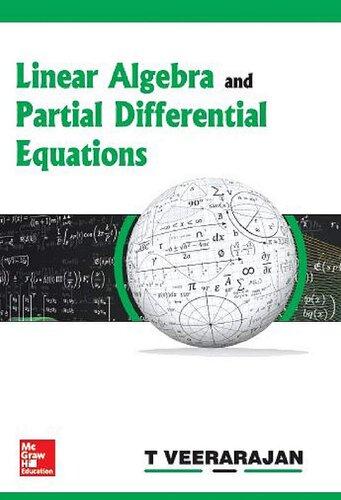ForewordandIntroduction
Wearelivinginaneraofinternet,WiFi,mobileapps,Facebook,Twitters,Instagram,selfies,clouds, ...–surelywehavenotnamedthemall,butonething certainisthatthesealldealwithdigitalandcomputer-generateddata.Thereis atrendynameforthevirtualspaceofallthesethingstogether: bigdata.The sizeofthebigdataspaceisever-growingwithanexponentialrate.Majorissues suchasanalytics,effectiveprocessing,storage,mining,prediction,visualization,compression,andencryption/decryptionofbigdatahavebecomeproblems ofmajorinterestincontemporarytechnology.
Thisbookaimsattreatingnumericalmethodsforpartialdifferentialequations(PDEs)inscienceandengineering.Appliedmathematicians,scientists, andengineersarealwaysdealingwithbigdata,allthetime.Wheredotheirbig dataoriginate?Theycome,mostly,fromproblemsandsolutionsofequationsof physicalandtechnologicalsystems.Alargenumberofthemodelingequations arePDEs.Therefore,effectivemethodsandalgorithmsforprocessingandresolvingsuchdataaremuchindemand.Thisis not atreatiseon generalbigdata However,themainobjectiveistodevelopamethodologythatcaneffectively helpresolvethechallengesofdealingwithlargedatasetsandwithspeedupin treatingtime-dependentPDEs.
Ourapproachhereis not thewayinwhichstandardtextbooksonnumerical PDEsarewritten.Thecentralthemeofthisbookisactuallyonthetechnical treatmentforeffectivemethodsthatcangeneratenumericalsolutionsfortimedependentPDEsinvolvingonlyasmallsetofdata,butyielddecentsolutions thatareaccurateandsuitableforapplications.Itreducesdatastorage,CPUtime, and,especially,computationalcomplexity–severalordersofmagnitude.The keyideaandmethodologyis properorthogonaldecomposition(POD),from propertiesofeigensolutionstoaprobleminvolvingalargedataset.(Indeed, PODhasbeenknownasaneffectivemethodforbigdataevenbeforetheterm bigdatawascoined.)Intheprocess,wehavedevelopedthenecessarymathematicalmethodsandtechniquesadaptingPODtofundamentalnumericalPDE methodsoffinitedifferences,finiteelements,andfinitevolumeinconnection withvariousnumericalschemesforawideclassoftime-dependentPDEsas showcases.
PDESANDTHEIRNUMERICALSOLUTIONS
Physical,biological,andengineeringprocessesarecommonlydescribedby PDEs.Suchprocessesarenaturallydynamic,meaningthattheirtimeevolution constitutesthemainfeatures,properties,andsignificanceofthesystemunder investigationorobservation.ThespatialdomainsofdefinitionofthePDEsare usuallymultidimensionalandirregularinshape.Thus,therearefundamental difficultiesinvolvinggeometryanddimensionality.ThePDEsthemselvescan alsotakerathercomplexforms,involvingalargevarietyofnonlinearities,systemcouplings,andsourceterms.TheseareinherentdifficultiesofthePDEs thatcompoundthoseduetogeometryanddimensionality.Ingeneral,exact(analytic)nontrivialsolutionstoPDEsarerarelyavailable.Numericalmethodsand algorithmsmustbedevelopedandthenimplementedoncomputerstorenderapproximatenumericalsolutions.Therefore,computationsbecometheonlyway totreatPDEproblemsquantitatively.ThestudyofnumericalsolutionsforPDEs isnowamajorfieldincomputationalsciencethatincludescomputationalmathematics,physics,engineering,chemistry,biology,atmospheric,geophysicaland oceansciences,etc.
ComputationalPDEsrepresentanactive,prosperousfield.Newmethods anddevelopmentsareconstantlyemerging.However,threecanonicalschemes standout: finitedifference (FD), finiteelement (FE),and finitevolumeelement (FVE)methods.Thesemethodsallrequirethedivisionofthecomputationaldomainintomeshes.Thus,theyinvolvemanydegreesoffreedom,i.e.,unknowns, whicharerelatedtothenumberofnodesofmeshpartitionofthecomputationaldomains.Foraroutine,real-worldprobleminengineering,thenumberof unknownscaneasilyreachhundredsofthousandsorevenmillions.Thus,the amountofcomputationalloadandcomplexityisextremelyhigh.Theaccuracy ofnumericalsolutionsisalsoaffectedastruncationerrorstendtoaccumulate. Foralarge-scaleproblem,theCPUtimeonasupercomputermayrequiredays, weeks,orevenmonths.Itispossible,forexample,ifweusethesecanonical methodsofFD,FE,andFVEtosimulatetheweatherforecastinatmospheric science,afteraprotractedperiodofcomputercalculations,thattheoutputnumericalresultshavealreadylosttheirsignificanceasthedaysofinterestare bygone.
Therearetwowaysofthinkingfortheresolutionofthesedifficulties.First, onecanthinkofcomputerspeedupbybuildingthebestsupercomputerswith continuousrefinement.AsofJune2016,theworld’sfastestsupercomputer ontheTOP500(http://top500.org)supercomputerlististheSunwayTaihuLightinChina,withaLINPACKbenchmarkscoreof93PFLOPS(Peta,or 1015 ,FLOPS),exceedingthepreviousrecordholder,Tianhe-2,byaround59 PFLOPS.Tianhe-2haditspeakelectricpowerconsumptionat17.8MW,and itsannualelectricitybillismorethan$14millionor100millionChineseYuan. Thus,mosttier-1universitiescannotaffordtopaysuchahighexpense.The secondoptionistoinsteaddevelophighlyeffectivecomputationalmethodsthat canreducethedegreesoffreedomforthecanonicalFD,FE,andFVEschemes,
lightenthecomputationalload,andreducetherunningCPUtimeandtheaccumulationoftruncationerrorsinthecomputationalprocesses.Thisapproachis basedoncost-optimal,rational,andmathematicalthinkingandwillbetheone takenbyushere.
Thefocaltopicofthebook,thePODmethod(see[56,60]),isoneofthe mosteffectivemethodsthataimsexactlyathelpingcomputationalPDEs.
THEADVANTAGESANDBENEFITSOFPOD
ReducethedegreesoffreedomofnumericalcomputationalmodelsfortimedependentPDEs,alleviatethecalculationload,reducetheaccumulationof truncatederrorsinthecomputationalprocess,andsaveCPUcomputingtime andresourcesforlarge-scalescientificcomputing.
PODinaNutshell
ThePODmethodessentiallyprovidesanorthogonalbasisforrepresentinga givensetofdatainacertainleast-squaresoptimalsense,i.e.,itofferswaysto findoptimallower-dimensionalapproximationsforthegivendataset.
ABriefPriorHistoryoftheDevelopmentofPOD
ThePODmethodhasalonghistory.ThepredecessorofthePODmethodwas aneigenvectoranalysismethod,whichwasinitiallypresentedbyK.Pearsonin 1901andwasusedtoextracttargeted,mainingredientsofhugeamountsofdata (see[132]).(Thetrendynameofsuchdatais“bigdata”.)Pearson’sdatamining, sampleanalysis,anddataprocessingtechniquesarerelevanteventoday.
However,themethodofsnapshotsforPODwasfirstpresentedbySirovich in1987(see[150]).ThePODmethodhasbeenwidelyandsuccessfullyappliedtonumerousfields,includingsignalanalysisandpatternrecognition(see [43]),statistics(see[60]),geophysicalfluiddynamicsormeteorology(see also[60],[60]or[78]),andbiomedicalengineering(see[48]).Foralong timesince1987,thePODmethodwasmainlyusedtoperformtheprincipalcomponentanalysisinstatisticalcomputationsandtosearchforcertain majorbehaviorofdynamicsystems(seereduced-orderGalerkinmethodsfor PDEs,proposedintheexcellentworkin2001byKunischandVolkweind[62, 63]).Fromthatmomentforth,themodelreductionorreducedbasisofthe numericalcomputationalmethodsbasedonPODforPDEsunderwentsome rapiddevelopment,providingimprovedefficiencyforfindingnumericalsolutionstoPDEs(see[2,11,15,19,45,48,54,57,58,135,137,138,141,166,167,170, 171,184–186,199]).Atfirst,Kunisch–Volkweind’sPOD-basedreduced-order Galerkinmethodswereappliedtoreduced-ordermodelsofnumericalsolutions forPDEswitherrorestimatespresentedin[62,63].Thoseerrorestimatesconsistofsomeuncertainmatrixnorms.Inparticular,theytook all thenumerical solutionsoftheclassicalGalerkinmethodonthetotaltimespan [0,T ] inthe
formulationofthePODbasis,usedthemtoestablishthePOD-basedreducedordermodels,andthenrecomputedthenumericalsolutionsonthesametime span [0,T ].Thisproducessomerepetitivecomputationbutnotmuchextragain. Onebeginstoponderhowtoimprovethisand,furthermore,howtogeneralize themethodologyinitiatedbyKunisch–Volkweind’sworkbeyondtheGalerkin FEmethodtootherFEmethodsandalsotoFDandFVEschemes.Thisbook aimsexactlyatansweringthesequestions.
DevelopmentofPODforTime-DependentPDEs
Thefirstauthor,ZhendongLuo,wasattractedtothestudyofreduced-ordernumericalmethodsbasedonPODforPDEsatthebeginningof2003.Atthattime, fewornocomprehensiveaccountsexistedandonlyfragmentaryintroductions aboutPODwereavailable.Hespentthreeyears(2003–2005)studyingtheunderlyingoptimizationmethods,statisticalprinciples,andnumericalsolutions forPOD.Then,in2006,heandhiscollaboratorspublishedtheirfirsttwopapersforPODmethods(see[26,27]).Thesedealtwithoceanicmodelsanddata assimilation.
Afterwards,LuoandhiscoauthorshaveestablishedsomePOD-based reduced-orderFDschemes(see[5,38,40,91,113,118,122,155])aswellasFE formulations(see[37,39,70,88–90,92,93,100,101,103,109,112,119,123,124, 164]).TheydeducedtheerrorestimatesforPOD-basedreduced-ordersolutions forPDEsofvarioustypessince2007inaseriesofpapers.Theyalsoproposed somePOD-basedreduced-orderformulationsandrelevanterrorestimatesfor POD-basedreduced-orderFVEsolutions(see[71,104,106,108,120])forPDEs inanotherseriesofpapersbeginningin2011.ThesePOD-basedreduced-order methodswerespecifictotheclassicalFDschemes,FEmethods,andFVEmethodsfortheconstructionofthereduced-ordermodels,inwhichtheyextracted onefromeverytenclassicalnumericalsolutionsas snapshots,significantlydifferentfromKunisch–Volkweind’smethods,inwhichnumericalsolutionsfrom theclassicalGalerkinmethodwereextractedatallinstantsonthetotaltime span [0,T ].Therefore,thesePOD-basedreduced-ordermethodsconstituteimprovements,generalizations,andextensionsforKunisch–Volkweind’smethods in[62,63].Thereduced-ordermethodsintheabovecitedworkneedonlyrepeat part ofthecomputationsonthesametimespan [0,T ]
Since2012,Luoandhiscollaboratorshaveestablishedthefollowingthree mainmethods:
i. PODROEFD:POD-basedreduced-orderextrapolationFDschemes(see[6, 7,79,81,94–96,102,110,111,117,121,127,154,158]);
ii. PODROEFE :POD-basedreduced-orderextrapolationFEmethods(see[69, 75,82,83,97,116,159–161,165,179]);
iii. PODROEFVE :POD-basedreduced-orderextrapolationFVEmethods(see [84,85,87,98,99,114,115,162,163]).
ThesePOD-basedreduced-order extrapolationmethods needonlyadoptthe standardnumericalsolutionsonsomeinitialrathershorttimespan [0,t0 ] (t0 T )of,respectively,theclassicalFD,FE,andFVEschemesassnapshotsin ordertoformulatethePODbasis.Therefore,theyhavesignificantlyimproved theprevious,existingversionofthereduced-ordermodels.Theydonothave torepeatwholesalecomputations.Thephysicalsignificanceisthatonecanuse existingdatatoforecastthefutureevolutionofnature.Furthermore,ourPODROEFD,PODROEFE,andPODROEFVEmethodscanbetreatedinasimilar wayastheclassicalFD,FE,andFVEmethods,leadingtoerrorestimateswith concreteordersofconvergence.TheapplicationofthesePOD-basedextrapolationmethodswillprovideanyonewith theadvantagesandbenefitsofPOD mentionedearlier.
Thesecondauthor,GoongChen,hasstronginterestsinthecomputation ofnumericalsolutionsofPDEsarisingfromreal-worldapplications.Hehas constantlybeenfacedwiththechallengestodealwiththeneedsforlarge datastorage,processspeedup,effectivereductionoforder,andtheextraction ofprominentphysicalfeaturesfromthesupercomputernumericalsolutionof PDEs.WhenhenoticedthatZhendongLuohadalreadydonesignificantwork onthePODmethodsfortime-dependentPDEsfittingmanyofhisneeds,he gotveryexcitedandproposedthatabookprojectbepreparedtopublishand promotethisveryimportanttopic.Thisstartedthecollaborationoftheauthors, withthisbookastheoutcome.Ourcollaborationisongoing,hopingmoreresearchpaperswillbeproducedinthenearfuturedemonstratingtheadvantages ofPOD-basedmethods.However,G.Chenhappilyacknowledgesthat alltechnicalcontributions inthisbookaretobecreditedtothefirstauthoralone.He haslearnedtremendouslyfromthecollaboration–thisbyitselfmakesthebook projectworthwhileandsatisfyingasfarasthesecondauthorisconcerned.
ORGANIZATIONOFTHEBOOK
Inthisbook,weaimtoprovidethetechnicaldetailsoftheconstruction,theoreticalanalysis,andimplementationsofalgorithmsandexamplesforPODROEFD, PODROEFE,andPODROEFVEmethodsforabroadclassofdynamicPDEs. Itisorganizedintothefollowingfourchapters.
Chapter 1 includesfoursections.Inthefirstsection,wereviewthebasictheoryofclassicalFDschemes.Itisintendedtoensuretheself-containednessofthe book.Then,inthesubsequentthreesections,weintroducetheconstruction,the theoreticalanalysis,andtheimplementationsofalgorithmsforthePODROEFD schemesforthefollowingtwo-dimensional(2D)PDEs:theparabolicequation, thenonstationaryStokesequation,andtheshallowwaterequationwithsedimentconcentration,respectively.Examplesanddiscussionsarealsogivenfor eachequation.
Chapter 2 issimilarlystructuredasChapter 1,withfoursections.There webeginbyreviewingthebasictheoryofSobolevspacesandelliptictheory,
theclassicalFEmethod,andthemixedFE(MFE)method.Thenwedescribe theconstruction,theoreticalanalysis,andimplementationsofalgorithmsforthe PODROEFEmethodsforthefollowing2DPDEs:theviscoelasticwaveequation,theBurgersequation,andthenonstationaryparabolizedNavier–Stokes equation(forwhichthestabilizedCrank–Nicolsonextrapolationschemeis used),respectively.Numericalexamplesandgraphicsareagainillustrated.
Chapter 3 containsthreesections,aimingatthetreatmentofPODROEFVE. WefirstintroducethebasicsofFVE.Thenthreesectionsfortheconstruction, theoreticalerroranalysis,andtheimplementationsofalgorithmsforthePODROEFVEmethodsforthefollowingthree2DdynamicPDEsarestudied:the hyperbolicequation,Sobolevequation,andincompressibleBoussinesqequation,respectively,aredeveloped,withconcreteexamplesandillustrations.
Numericalresultsonthesemodelequationsaspresentedinthebookhave demonstratedtheeffectivenessandaccuracyofourPODmethods.
Finally,Chapter 4 isashortepilogueandoutlook,consistingofconcluding remarksandforward-lookingstatements.
Thebookiswrittentobeasself-containedaspossible.Readersandstudents needonlytohaveanundergraduatelevelinappliedandnumericalmathematicsfortheunderstandingofthisbook.Manypartscanbeusedasastandard graduate-leveltextbookonnumericalPDEs.Thetheory,methods,andcomputationalalgorithmswillbevaluabletostudentsandpractitionersinscience, engineering,andtechnology.
ACKNOWLEDGMENTS
Theauthorsthankallcollaborators,colleagues,andinstitutionsthathavegenerouslysupportedourwork.Inparticular,theauthorsaredelightedtoacknowledgethepartialfinancialsupportovertheyearsbytheNationalNaturalScience FoundationofChina(undergrant#11671106),theQatarNationalResearch Fund(undergrant#NPRP8-028-1-001),theNorthChinaElectricPowerUniversity,andtheTexasA&MUniversity.
Decomposition
Thekeyobjectiveofthisbookistodevelopthenumericaltreatmentsof properorthogonaldecomposition (POD)for partialdifferentialequations (PDEs).WithregardtonumericalmethodsforPDEs,the finitedifference (FD)methodessentiallyconstitutesthebasisof all numericalmethodsfor PDEs.InordertointroducehowPODworks,itisnaturaltostartwiththe FDmethod.
Forthesakeofproperself-containedness,inthischapterwefirstreviewthe basictheoryofclassicalFDschemes.Wethenintroducetheconstruction,theoreticalanalysis,andimplementationsofalgorithmsforthePOD-basedreducedorderextrapolationFD(PODROEFD)schemesforthetwo-dimensional(2D) parabolicequation,2Dnonstationary Stokesequation,and2D shallowwaterequationwithsedimentconcentration.Finally,weprovidesomenumerical examplestoshowwhatthePODROEFDschemeshaveovertheclassicalFD schemes.Moreover,itisshownthatthePODROEFDschemesarereliableand effectiveforsolvingabove-mentionedPDEs.
Thenumericalmodelstreatedhereincludebothsimpleequationsandcoupledsystems.Thesystematicapproachwetakeinthischapter,namely,followingthelogicalsequenceof rudiments, modelingequations, errorestimatesstability-convergence, PODmethods, errorestimatesforPODsolutions,and finally concretenumericalexamples,willbethestandardforallchapters.
1.1REVIEWOFCLASSICALBASICFINITEDIFFERENCE THEORY
1.1.1ApproximationofDerivative
TheFDschemesusedifferencequotientstoapproximatederivatives.Denote uni,j = u(i x,j y,n t) = u(xi ,yj ,tn ).Then un i ±1,j ±1 = u(xi ± x,yj ± y,tn ), u n±1 i,j = u(xi ,yj ,tn ± t). Derivativeapproximationshaveusuallythefollowingfourforms.
1. Approximationtofirst-orderderivativebyaforwarddifference
Wehave
2. Approximationtofirst-orderderivativebyabackwarddifference
Wehave
3. Approximationtofirst-orderderivativebyacentraldifference
Wehave
4. Approximationtosecondderivativebyasecond-ordercentraldifference
Wehave
1.1.2DifferenceOperators
1. Thedefinitionsofdifferenceoperators
Wedenoteoperators I,Ex ,E 1 x , x , ∇x ,δx ,μx bythefollowing:
Iun j = un j ; I isknownastheunitoperator;
Ex un j = un j +1 ; Ex isknownastheforwardshiftoperatoranddenotedby
Ex = E +1 x ;
E 1 x un j = un j 1 ; E 1 x isknownasthebackwardshiftoperatoranddenotedby
Ex = E 1 x ;
x un j = un j +1 un j ; x isknownastheforwarddifferenceoperatorandsatisfies x = Ex I ;
∇x un j = un j un j 1 ; ∇x isknownasthebackwarddifferenceoperatorand satisfies ∇x = I Ex ;
δx un j = un j + 1 2 un j 1 2 ; δx isknownastheonestepcentraldifferenceand satisfies δx = E 1 2 x E 1 2 x ; μx un j = 1 2 (uj + 1 2 + uj 1 2 ); μx isknownastheaverageoperatorandsatisfies
μx = 1 2 (E 1 2 x + E 1 2 x ).
2. Compositedifferenceoperators
Wehave
i. (μδ)x = 1 2 (Ex E 1 x ) = 1 2 ( x +∇x );
ii. (δx )2 = δx δx = (E 1 2 x E 1 2 x )2 = (Ex 2I + E 1 x ); iii. (δx )n = δx (δn 1 x ); n x = x n 1 x =···;∇ n x =∇x ·∇ n 1 x =··· .
3. Derivativerelationswithdifferenceoperators
Wehave i ∂u ∂x n j = x un j x + O( x)—forwarddifference = ∇x un j x + O( x)—backwarddifference
= δx un j x + O( x 2 )—centraldifference; ii ∂ 2 u ∂x 2 n j = δ 2 x un j x 2 + O( x 2 )—thesecond-ordercentraldifference
= 2 x un j x 2 + O( x 2 )—thesecond-orderforwarddifference
= ∇ 2 x un j x 2 + O( x 2 )—thesecond-orderbackwarddifference.
1.1.3TheFormationofDifferenceEquations
1. ExplicitFDschemes
TheexplicitFDschemeimpliesthatthetimefarthestpointvaluesappear onlyonce.Forexample,
isanexplicitFDschemefor
isapositive“diffusioncoefficient”.
2. ImplicitFDschemes
TheimplicitFDschemesimplythatthetimefarthestpointvaluesintheFD schemeappearmorethanonce.Forexample,
3. Semidiscretizeddifferenceschemes
Thesemidiscretizeddifferenceschemeimpliesthatonlythespatialvariable isdiscretizedandthetimevariableisnotdiscretized.Forexample,
1.1.4TheEffectivenessofFiniteDifferenceSchemes
1. TheerrorofanFDscheme Fortheequation
consideranFDschemediscretizedbyforwarddifferencefortimeandcentral differenceforspace(FTCS)asfollows:
whichisexpandedatreferencepoint (xj ,tn ) byTaylor’sformulainto
TheaboveequationisknownasthemodifiedPDE,wherethefirstparenthesis aboveiscalledthesourceequation(i.e.,PDE)andthebracketaboveiscalled the remainder (R)or truncationerror (TE),denotedbyR = TE.
TheTEisequaltothesourceequation(PDE)subtractingtheFDequation (FDE),i.e.,TE = PDE FDE.
The discretizationerror (DE,i.e.,theerroroftheFDscheme)isequalto theTEplusthe boundaryerror (BE),i.e.,DE = TE + BE.Thus,DE = BE + PDE FDE.
The round-offerror (ROE)denotestheroundingerrorofthecomputingprocedurebythecomputerandthetotalerrorisdenotedbyCE.Then
CE = DE + ROE = BE + PDE FDE + ROE.
However,ROEandBEareusuallyomitted.TheerrorofFDschemesmainly considersTE,whichisdirectlyobtainedfromtheapproximationofthederivative(1.1.1)–(1.1.4).
2. TheconsistencyofanFDscheme
Definition1.1.1. (1)LetthePDE
bediscretizedbyanFDschemeasfollows:
WhenanFDgridisindefinitelyrefinedandif R = TE satisfiestheproperty thatittendstozero,i.e.,
thentheFDschemeissaidtobe compatible withthesourceequation.
(2)If t = o( x γ )(γ> 0),i.e.,lim x →0 t →0 t x γ = 0,wehave R → 0,thenthe FDschemeissaidtobecompatiblewiththesourceequationontheconditions t = o( x γ )(γ> 0).
3. ThestabilityofanFDscheme
Definition1.1.2. i.Ifanerrordisturbance εn j =˜un j un j isaddedatcertaintime level t = tn ,i.e., ˜ un j = un j + εn j ,andtheerrors ε n+1 j =˜u n+1 j u n+1 j ofsolutions u n+1 j and u n+1 j obtainedfromtheFDscheme(1.1.6)donotproduceextra-large overallgrowth,i.e.,thereisaconstant K> 0independentof n and j suchthat
εn+1 j K εn j , oromitting j, εn+1 K εn , where · representsanorm,thenwhen0 <K< 1,theFDscheme(1.1.6)is saidtobe stronglystable,else(when K 1)theFDscheme(1.1.6)issaidtobe weaklystable.
ii.Ifthereisnorestrictionbetweenthetimestepandthespatialstepinthe FDscheme(1.1.6),itissaidtobe absolutelystable or unconditionallystable. Inthiscase,thetimestep t cantakealargersize.
iii.IfthestabilityoftheFDscheme(1.1.6)isrestrictedbysomerelationship oftimestepandspatialsteps(usuallyconstrainedintheformofsomeinequalities,forexample, t = o( x γ )(γ> 0)),thenitissaidtobe conditionally stable
WehavethefollowingcriteriaforthestabilityoftheFDscheme(1.1.6)(see [192,194]).
Theorem1.1.1. TheFDscheme(1.1.6)isstableifandonlyiftherearetwo positiveconstants t0 and x0 aswellasanonnegativeconstant K> 0 independentof n and j suchthatthesolutionsofFDscheme(1.1.6)satisfy un j K,n = 1, 2,....
Theorem1.1.2. IftheFDscheme(1.1.6)ofPDE(1.1.5)satisfies
n+1 j · un j > 0,
where · isadiscretenorm,thentheFDscheme(1.1.6)isstable.
4. EquivalencebetweenstabilityandconvergencyofFDschemes
Definition1.1.3. i.Let u∗ (x,t) beanexactsolutionforPDE(1.1.5)and un j theapproximatesolutionsoftheFDscheme(1.1.6)compatiblewiththe PDE(1.1.5).Ifwhen t → 0, x → 0(i.e.,gridisinfinitelyrefined),forany sequence (xj ,tn ) → (x ∗ ,t ∗ ) ∈ ,wehave lim x, t →0 un j = u ∗ (x ∗ ,t ∗ ), (1.1.9)
thentheFDscheme(1.1.6)issaidtobe convergent.
ThestabilityandconvergenceofFDschemesaretheirintrinsicproperties withthefollowingimportantequivalence(see[192]or[194,Theorem1.3.18]).
Theorem1.1.3. IfthePDE(1.1.5)iswellposed,i.e.,ithasauniquesolution andiscontinuouslydependentoninitialboundaryvalueconditionsandcompatiblewithitsFDscheme(1.1.6),thenthestabilityoftheFDscheme(1.1.6)is equivalenttoitsconvergence.
Theorem 1.1.3 isbrieflydescribedas“ifaPDEiswellposedandcompatible withitsFDscheme,thenthestabilityoftheFDscheme(1.1.6)isequivalentto itsconvergence”.
Remark1.1.1. ForlinearPDEs,iftheirFDschemesarestable,thentheirconvergenceisensured.Therefore,itisonlynecessarytodiscusstheirstability. However,fornonlinearPDEs,becauseofthecomplexity,atpresentwecan onlyinvestigatenearlysimilarconvergenceandlocalstabilityanalysisinstead ofglobalanalysisofconvergence.
5. VonNeumann’sstabilityanalysisofFDschemes
VonNeumann’sstabilityanalysisofFDschemesisalsoknownasthe Fourieranalysismethod.InordertoanalyzethestabilityofFDschemes,we firstdiscussthestabilityofexactsolutions.
i. Stabilityanalysisofexactsolution
Theinitialvalueproblem
issaidtobe wellposed,ifithasauniqueandstablesolution.Aso-calledstable solutionmeansthatthesolutioniscontinuouslydependentontheinitialvalue andcanmaintaintheboundednessofsmalldisturbances.
Assumethattheinitialvalue φ(x) isperiodicandexpandableintothefollowingFourierseries:
wherethe fk saretheFouriercoefficients.Assumethattheexactsolution u(x,t) oftheinitialvalueproblem(1.1.10)isalsoexpandableintothefollowingFourier series:
wherethe Fk (t)saretheFouriercoefficientsoftheseriesdependingon t
Bysubstituting(1.1.12)intothefirstequationof(1.1.10),weobtain k Fk (t)eikx = L( ∂ ∂x , ∂ ∂x 2 , ··· ) k Fk (t)eikx =
If L isalineardifferentialoperator,wecanrewrite(1.1.13)asfollows: k Fk (t)eikx = k L(ik,(ik)2 , ··· )eikx · Fk (t). (1.1.14)
Bycomparingthecoefficients eikx oftheLHSandthoseoftheRHSin(1.1.14) andsettingthemequal,wehave Fk (t) = L(ik,(ik)2 , ··· ) · Fk (t). (1.1.15)
Eq.(1.1.15)hasageneralsolutionasfollows: Fk (t) = ck eL(ik,(ik)2 , ··· )t (1.1.16)
Byusingtheinitialcondition u(x, 0) = φ(x) of(1.1.10),weobtain k fk eikx = k Fk (0)eikx ,whichimplies ck = Fk (0) = fk .Thus,(1.1.12)can berewrittenasfollows: u(x,t) = k fk eL(ik,(ik)2 , )t · e ikx . (1.1.17)
Notethattheexactsolution u(x,t) issaidtobestable,ifthereisanonnegative constant M ,independentof u,t ,and x ,suchthat u(x,t) L2 M u(x, 0) L2 (1.1.18)
Because {eikx } isasetofstandardorthogonalbasesin L2 ( π,π),wehave u(x,t) 2 L2 = k | fk eL(ik,(ik)2 , ··· )t |2 k | fk |2 sup | eL(ik,(ik)2 , )t |2 , (1.1.19)
u(x, 0) 2 L2 = k | fk |2 , (1.1.20) where u(x,t) L2 = π π | u(x,t) |2 dx 1/2 isthenormof u( ,t) in L2 ( π,π)
From(1.1.19)–(1.1.20),weknowthat | eL(ik,(ik)2 , )t | M (1.1.21) holdsifandonlyif u(x,t) 2 L2 = k | fk eL(ik,(ik)2 , )t |2
Thus,theexactsolution u(x,t) of(1.1.10)isstableifandonlyifthereisa nonnegativeconstant M independentof u,t ,and x ,suchthat | eL(ik)t | M .
ii. StabilityanalysisofanFDscheme
Inthefollowing,weanalyzethevonNeumannstabilityconditionsofanFD scheme.
Let(1.1.10)havethefollowingFDscheme:
Lettheinitialtimelevel (n = 0) bedenotedas u
Letthe nthtimelevelsolution un j bedenotedby
Byinserting(1.1.25)into(1.1.23),andbythestandardorthogonalityof {eikx },weobtain
where Z isthesetofallintegersand G isknownasthe growthfactor,whichis denotedbythefollowingequation:
Let g = (··· ,g k , ··· ,g 2 ,g
).Wehave
ByusingEq.(1.1.28),wehave
where · 2 representsthenormin l 2 .Thus,by(1.1.24)and(1.1.25),from (1.1.29),weobtain
Then,byTheorem 1.1.1,weobtainthefollowingresult.
Theorem1.1.4. TheFDscheme(1.1.13)isstableifandonlyiftherearetwo positiveconstants t0 and x0 aswellasanonnegativeconstant K> 0 independentof n and j ,suchthatitsgrowthfactor G satisfies
Corollary1.1.5. TheFDscheme(1.1.13)isstableifandonlyifitsgrowth factor G satisfies
iii. VonNeumann’sstabilityanalysisofFDschemes
Theconditionof(1.1.32)inCorollary 1.1.5 isusuallyknownasthe von Neumannstability condition.Itfollowsthatinordertodistinguishthestability oftheFDscheme(1.1.13),itisnecessarytocomputeitsgrowthfactor G by formula(1.1.27)anddeterminethe t and x suchthat(1.1.32)or G 1is satisfied.
ForspecificFDschemes,itiseasytocomputetheirgrowthfactor G by (1.1.27).Bythestandardorthogonalityof {eikx },itisnecessarytosubstitute
intotheFDscheme(1.1.13),andthen,eliminatingsomecommonfactors,one canobtainthegrowthfactor G of(1.1.27).
ForanFDschemefortwo-dimensionallinearPDEs,weneedonlytosubstitute unj,m = Gn eikxj eikym (n = 1, 2, ··· ) intotheFDschemeandthensimplify, sowecanalsoobtainthegrowthfactor G. Somerelativeexamplescanbefoundin[192].
1.2APOD-BASEDREDUCED-ORDEREXTRAPOLATION
FINITEDIFFERENCESCHEMEFORTHE2DPARABOLIC EQUATION
Inthissection,weintroducethePODROEFDschemeforthetwo-dimensional (2D)parabolicequation.TheworkisbasedonLuoetal.[111].
Forconvenienceandwithoutlossofgenerality,let = (ax ,bx ) × (cy ,dy ) andconsiderthefollowing2Dparabolicequation.
Find u suchthat
ut − u = f,(x,y,t) ∈ × (0,T), u(x,y,t) = g(x,y,t),(x,y,t) ∈ ∂ ×[0,T), u(x,y, 0) = s(x,y), (x,y) ∈ ,
(1.2.1)
where f(x,y,t), g(x,y,t),and s(x,y) aregivensourceitem,boundaryfunction,andinitialvaluefunction,respectively,and T isthetotaltimeduration.
Themainmotivationandphysicalbackgroundoftheparabolicequationare themodelingofheatconductionanddiffusionphenomena.
1.2.1AClassicalFiniteDifferenceSchemeforthe2DParabolic Equation
Let x and y bethespatialstepsinthe x and y directions,respectively, t the timestep,and unj,k thefunctionvalueof u atpoints (xj ,yk ,tn ) (0 j J = [(bx ax )/ x ],0 k K =[(dy cy )/ y ], 0 n N =[T/ t ],where [(bx ax )/ x ], [(dy cy )/ y ],and [T/ t ] denotetheintegralpartsof (bx ax )/ x , (dy cy )/ y ,and T/ t ,respectively).
Thus,theforwarddifferenceexplicitschemeforthe2Dparabolicequation(1.2.1)atreferencepoint (xj ,yk ,tn ) isgivenby
FortheFDscheme(1.2.2),wehavethefollowingstabilityandconvergence.
Theorem1.2.1. If 4 t/ x 2 1 and 4 t/ y 2 1,theFDscheme(1.2.2)is stabile.Further,wehavethefollowingerrorestimates:
Proof. If4 t/ x 2 1and4 t/ y 2 1,wehave
where · ∞ isthe L∞ ( ) norm.Thus,from(1.2.4),weobtain
Bysumming(1.2.4)from0to n 1,weobtain un ∞ u 0 ∞ + n t f ∞ ,n = 1, 2, ··· ,N. (1.2.6)
Because n t T ,from(1.2.6),weobtain un ∞ s(x,y) ∞ + T f ∞ ,n = 1, 2, ,N, (1.2.7)
whichshowsthatsolutionsoftheFDscheme(1.2.2)areboundedandcontinuouslydependentontheinitialvalue s(x,y) andsourceterm f(x,y,t).Thus, byTheorem 1.1.1,wededucethattheFDscheme(1.2.2)isstable.Furthermore, theerrorestimates(1.2.3)aredirectlyobtainablefromapproximatingdifference quotientsforderivatives.
Thus,aslongasthetimestep t ,thespatialsteps x and y , f(x,y,t), g(x,y,t),and s(x,y) aregiven,wecanobtainclassicalFDsolutions unj,k (0 j J, 0 k K, 0 n N) forthe2Dparabolicequation(1.2.1)bycomputingtheFDscheme(1.2.2).
1.2.2FormulationofthePODBasis
Set un i = unj,k and f n i = f n j,k (1 i m ≡ (J + 1)(K + 1),i = kJ + k + j + 1, 0 j J, 0 k K, 0 n N).Then,theclassicalFDsolutionsfortheFD scheme(1.2.2)canbedenotedby {un i }N n=1 (1 i m).Weextractthefirst L sequenceofsolutions {un i }L n=1 (1 i m,L N) as snapshots.Further,we formulatean m × L snapshotmatrix
Bythesingularvaluedecomposition,thesnapshotmatrix A hasafactorization
where l ×l = diag{σ1 ,σ2 , ··· ,σl } isadiagonalmatrixconsistingofthesingularvaluesof A accordingtothedecreasingorder σ1 σ2 ··· σl > 0, U = (ϕ 1 , ϕ 2 , ··· , ϕ m ) isan m × m orthogonalmatrixconsistingoftheorthogonaleigenvectorsof AAT ,whereas V = (φ 1 , φ 2 , ··· , φ L ) isan L × L orthogonal matrixconsistingoftheorthogonaleigenvectorsof AT A,and O isazeromatrix.
Becausethenumberofmeshpoints m is muchlarger thanthatofsnapshots L extracted,theheight m of A formatrix AAT ismuchlargerthanthe width L of A formatrix AT A,butthepositiveeigenvalues λj (j = 1, 2, ··· ,l ) of AT A and AAT areidenticalandsatisfy λj = σ 2 j (j = 1, 2, ··· ,l ).Therefore,wemayfirstfindtheeigenvalues λ1 λ2 ··· λl > 0(l = rank A)for matrices AT A andcorrespondingeigenvectors ϕ j .Then,bytherelationship
ϕ j = Aφ j / λj ,j = 1, 2,...,l,
weobtaintheseeigenvectors ϕ j (j = 1, 2,...,l )correspondingtothenonzero eigenvaluesformatrix AAT . Take
where M ×M = diag{σ1 ,σ2 , ··· ,σM } isthediagonalmatrixconsistingofthe first M positivesingularvaluesofthediagonalmatrix l ×l .Definethenorm ofmatrix A as A 2,2 = supu∈RL Au 2 / u 2 (where u 2 isthe l 2 normfor vector u).
Wehavethefollowing.
Lemma1.2.2. Let = (ϕ 1 , ϕ 2 , , ϕ M ) consistofthefirst M eigenvectors U = (ϕ 1 , ϕ 2 , , ϕ m ).Then,wehave
Proof. Accordingto
wehave
Thus,bytherelationshipbetweenthematrixnormanditsspectralradius, wehave min rank(B ) M
where = (ϕ 1 , ϕ 2 , , ϕ M ) consistsofthefirst M eigenvectors U = (ϕ 1 , ϕ 2 , ··· , ϕ m ).Ifthe L columnvectorsof A aredenotedby un = (un 1 ,un 2 , ··· , unm )T (n = 1, 2, ··· ,L),wehave un un M
where un M = M j =1 (ϕ j , un )ϕ j representstheprojectionof un onto = (ϕ 1 , ϕ 2 , ··· , ϕ M ), (ϕ j , un ) istheinnerproductof ϕ j and un ,and ε n denotes theunitvectorwiththe nthcomponentbeing1.Theinequality(1.2.13)shows that un M isanoptimalapproximationof un whoseerrorisnomorethan √λM +1 Thus, isjustanorthonormaloptimalPODbaseof A.
1.2.3EstablishmentofthePOD-BasedReduced-OrderFinite DifferenceSchemeforthe2DParabolicEquation
WestilldenotetheclassicalFDsolutionvectorsfromtheFDscheme(1.2.2)by un = (un 1 ,un 2 , ,unm )T (n = 1, 2, ,L,L + 1, ,N ).Thus,wecanwrite
theFDscheme(1.2.2)invectorformasfollows:
Inordertoestimateatridiagonalmatrix,itisnecessarytointroducethe followinglemma(see[192,Theorems1.3.1and1.3.2]).
Lemma1.2.3. Thetridiagonalmatrix













